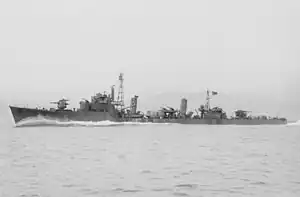 Momo underway, 3 June 1944 | |
| History | |
|---|---|
| Name | Momo |
| Namesake | Peach |
| Builder | Maizuru Naval Arsenal |
| Laid down | 5 November 1943 |
| Launched | 25 March 1944 |
| Completed | 10 June 1944 |
| Fate | Sunk by USS Hawkbill, 15 December 1944 |
| General characteristics (as built) | |
| Class and type | Matsu-class escort destroyer |
| Displacement | 1,282 t (1,262 long tons) (standard) |
| Length | 100 m (328 ft 1 in) (o/a) |
| Beam | 9.35 m (30 ft 8 in) |
| Draft | 3.3 m (10 ft 10 in) |
| Installed power | 2 × water-tube boilers; 19,000 shp (14,000 kW) |
| Propulsion | 2 shafts, 2 × geared steam turbines |
| Speed | 27.8 knots (51.5 km/h; 32.0 mph) |
| Range | 4,680 nmi (8,670 km; 5,390 mi) at 16 knots (30 km/h; 18 mph) |
| Complement | 210 |
| Sensors and processing systems | |
| Armament |
|
Momo (桃, "Peach") was one of 18 Matsu-class escort destroyers built for the Imperial Japanese Navy during World War II. She was built at the Maizuru Naval Arsenal on June 10, 1944. She operated primarily in the Philippines and would be sunk there by torpedoes fired from the submarine USS Hawkbill.
Career
Momo was assigned to the 11th Destroyer Squadron for training and then on July 15, 1944, she would be put in the 43rd Destroyer Division. On August 20 she was moved to the 31st Escort Squadron[1]
On October 25 the escort carrier Kaiyo and light aircraft carrier Ryūhō would leave Sasebo escorted by Momo, Momi, and Ume for an aviation material transport to Keelung in Taiwan. They would make the trip there and returned to Kure safely.[2]
On November 14, 1944, Momo and the light cruiser Isuzu departed Kure for a troop transport to Brunei. They docked in Manila on November 18 and departed for Brunei the next day. The Isuzu was struck by a torpedo from the submarine USS Hake killing 32 of her sailors. Momo was not damaged during the engagement and Isuzu was diverted to Singapore for temporary repairs.[3]
On November 24, Momo and the destroyer Shimotsuki departed Singapore for Manila to support the "TA" transport operations. The next day November 25 Shimotsuki was hit by four torpedoes fired from the submarine USS Cavalla causing a large explosion breaking up the ship and was sunk. Momo searched for the enemy submarine but it was not found, she then returned shortly to pick up survivors. Of the almost 300-man crew only 46 were rescued.[4]
Battle of Ormoc Bay
The Battle of Ormoc Bay was a battle that was a part of the larger Battle of Leyte. There were nine resupply missions to Japanese positions in the Philippines TA No.1–9. Momo was assigned to TA No. 8 along with the destroyers Ume, Sugi, and the Sub-chasers No.18 and No.38. They were escorting the 68th Brigade to Leyte totaling 4,000 troops who were loaded onto the transport ships Akagisan Maru, Hakuba Maru, Shinsei Maru, Nichiyo Maru, and T.11 where they would move the troops to Ormoc.
On the morning of December 7 air attacks on the convoy began, American forces had begun landing a few miles south of Ormac during the Philippines campaign. Captain Sugama Ryokichi ordered the transport ships to run aground and begin unloading while the escort ships went north. Momo would later return to the ships but there was little to be done, the soldiers were able to get off but the ships were lost. Momo would accidentally clip a reef and suffer minor damage while rejoining the other destroyers, they then returned to Manila on December 8, 1944.[5]
Sinking
Momo and Sub-chaser No. 60 were assigned to escort the passenger ship Ōryoku Maru carrying 3,500 Japanese military personnel, civilians, and prisoners of war. They departed Manila on December 14 at 04:40. At 06:50 they were attacked by planes launched from the USS Hornet severely damaging the Oryoku Maru. After the ship was repaired and underway they were attacked by more planes from the Hornet on December 15 leading to the Oryoku Maru to be sunk while Momo would not receive any major damage from the aerial attacks.[6]
140 miles southwest of the coast of Cape Bolinao, Luzon, the submarine USS Hawkbill fired six torpedoes which hit Momo and sank her.[7] 36 of her crew were wounded and 92 were killed including her Commanding Officer Lt Cdr Minagawa Yoshio.[2]
Bibliography
- Jentschura, Hansgeorg; Jung, Dieter & Mickel, Peter (1977). Warships of the Imperial Japanese Navy, 1869–1945. Annapolis, Maryland: United States Naval Institute. ISBN 0-87021-893-X.
- Nevitt, Allyn D. (1998). "IJN Momo: Tabular Record of Movement". www.combinedfleet.com. Retrieved 21 September 2020.
- Rohwer, Jürgen (2005). Chronology of the War at Sea 1939–1945: The Naval History of World War Two (Third Revised ed.). Annapolis, Maryland: Naval Institute Press. ISBN 1-59114-119-2.
- Stille, Mark (2013). Imperial Japanese Navy Destroyers 1919–45 (2): Asahio to Tachibana Classes. Botley, UK: Osprey Publishing. ISBN 978-1-84908-987-6.
- Sturton, Ian (1980). "Japan". In Chesneau, Roger (ed.). Conway's All the World's Fighting Ships 1922–1946. Greenwich, UK: Conway Maritime Press. ISBN 0-85177-146-7.
- Whitley, M. J. (1988). Destroyers of World War Two: An International Encyclopedia. Annapolis, Maryland: Naval Institute Press. ISBN 0-87021-326-1.
- ↑ "Japanese monographs. | CRL Digital Delivery System". ddsnext.crl.edu. pp. 36, 37. Retrieved 2023-11-01.
- 1 2 "Long Lancers". www.combinedfleet.com. Retrieved 2023-11-01.
- ↑ "Imperial Cruisers". www.combinedfleet.com. Retrieved 2023-11-01.
- ↑ "Long Lancers". www.combinedfleet.com. Retrieved 2023-11-01.
- ↑ "Long Lancers". www.combinedfleet.com. Retrieved 2023-11-01.
- ↑ "Japanese Army Auxiliary Transports". www.combinedfleet.com. Retrieved 2023-11-01.
- ↑ "Hawkbill I (SS-366)". public2.nhhcaws.local. Retrieved 2023-11-01.